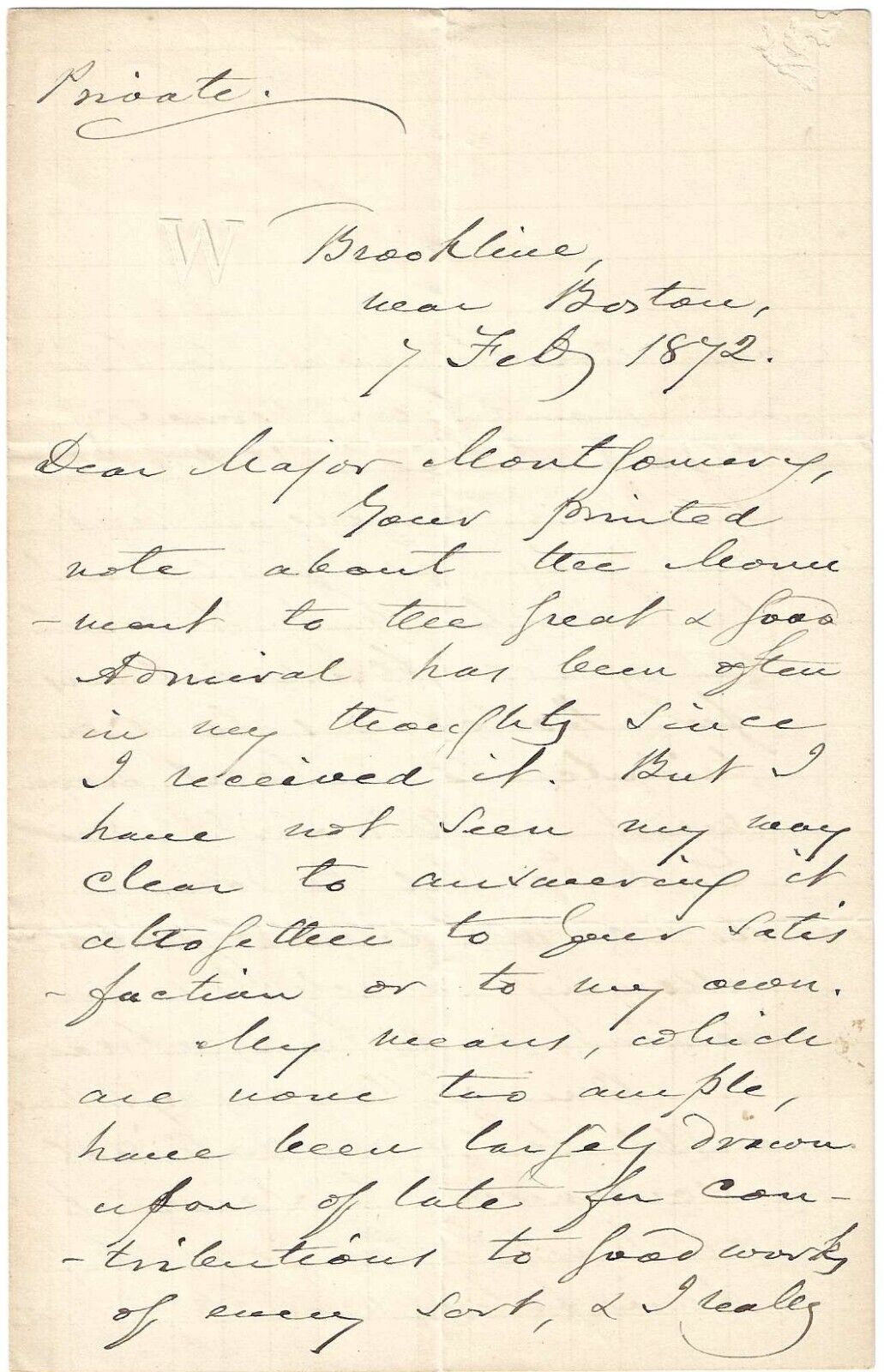|

On eBay Now...
Moderate Abolitionist Offers Analysis On Funding, Planning Monument To Farragut For Sale

When you click on links to various merchants on this site and make a purchase, this can result in this site earning a commission. Affiliate programs and affiliations include, but are not limited to, the eBay Partner Network.

Moderate Abolitionist Offers Analysis On Funding, Planning Monument To Farragut:
$295.00
ROBERT C. WINTHROP (1809-1894) was Speaker of the House of Representatives who replaced Daniel Webster as Speaker and adopted a moderate position on slavery. 7 pp, 5 ¼ x 8, ALS, “Robt. C. Winthrop” Brookline [MA], Feb. 7, 1872, to James Montgomery, regarding the funding of and planning for the monument honoring the renowned Naval Admiral David Farragut, which wouldn’t happen until 1881. “Your printed note about the monument to the great and good Admiral has been often in my thoughts...But I have not seen any way clear to answering it altogether to your satisfaction or my own. “My means, which are none too ample, have been largely drawn upon of late for contributions to good works of every sort, & I really am constrained to hold my hand in many cases which I should be glad to give. But in this case, I cannot but feel that it could be of doubtful fitness for Bostonians to contribute to a local monument of this sort. New York ought to do it & do it handsomely, without allowing much less soliciting aid from abroad. “One of these days, there ought to be a National Monument to Farragut at Washington or at Annapolis, near the Naval Academy, where the young Naval Cadets would be in the way of catching inspiration from a grand example of heroism. “But a local monument ought not to lack abundant contributions from New Yorkers; and I am [inclined] to believe that they will not be forthcoming soon. “I hope a design will be agreed on, & a place fixed in the streets or public squares of the city, where it may be seen, like Gen’l Worth’s monument by every passerby. It need not cost a great sum in order to be effective. A statue, on a pedestal, would hardly cost much more than you have already obtained. A stately monument of granite or marble would be even less expensive. Meantime, the National Monument might be reserved for a more distant day. Posthumous commemorations are all the more significant for being postponed. The Franklin Statue in Boston & the recently inaugurated in New York, are a thousand-fold more telling in regard to Franklin’s greatness & the gratitude of his countrymen, that if they had hurried up as soon as he was dead, or while he was still living. “Farragut will not be forgotten & the day will come when something worthy of him will be decided and executed. I hope to see it & to contribute my mite towards it. But if it be delayed long after I have followed him in the march which awaits us all, still it will be, sooner or later, and our posterity will see it if we do not. “It gives me real pain to decline anything which is proposed in honor of one to whom I was so...attached. But I feel that for the sake of his memory, as well as for the credit of New York, this work should be completed where it has been commenced. “I have never congratulated you on your marriage. I shall hope & pay my respects to Mrs. Montgomery whenever I am in your neighborhood... “Rob’t Winthrop “J.E. Montgomery, Esq” DAVID GLASGOW FARRAGUT (1801-1870) is regarded as the most distinguished naval commander during the Civil War and the first Admiral of the U.S. Navy. He is best remembered for his order at the Battle of Mobile Bay, usually paraphrased as “Damn the torpedoes, full speed ahead” in U.S. Navy tradition. He successfully achieved the bloodless surrender of New Orleans in 1862 and two years later supervised the capture of the Confederate defenses in Mobile Bay. With his death on August 14, 1870, plans for erecting a memorial flourished. The memorial was unveiled on April 25, 1881 and was one of the most intricate alliances between art and politics in the city’s history. Spanning nearly a decade, the planning and execution of the monument with a saga of artistic ambition, personal and political influence and elaborate maneuvering, sculptors, senators and representatives, officers of the army and navy, cabinet members and even Farragut’s widow were caught up in activities. Toning. One vertical fold. A couple of small holes away from the writing. A very fine letter. Everything we sell is guaranteed authentic forever to the original buyer. We also offer a 30-day return policy. If you discover a problem or are dissatisfied with an item, please contact us immediately. Our goal is to please every customer. We are pleased to be members of The Manuscript Society, Universal Autograph Collectors Club, The Ephemera Society, the Southern New England Antiquarian Booksellers and the Preferred Autograph Dealers and sale Houses. [M-125]


Moderate Abolitionist Offers Analysis On Funding, Planning Monument To Farragut $295.00
|